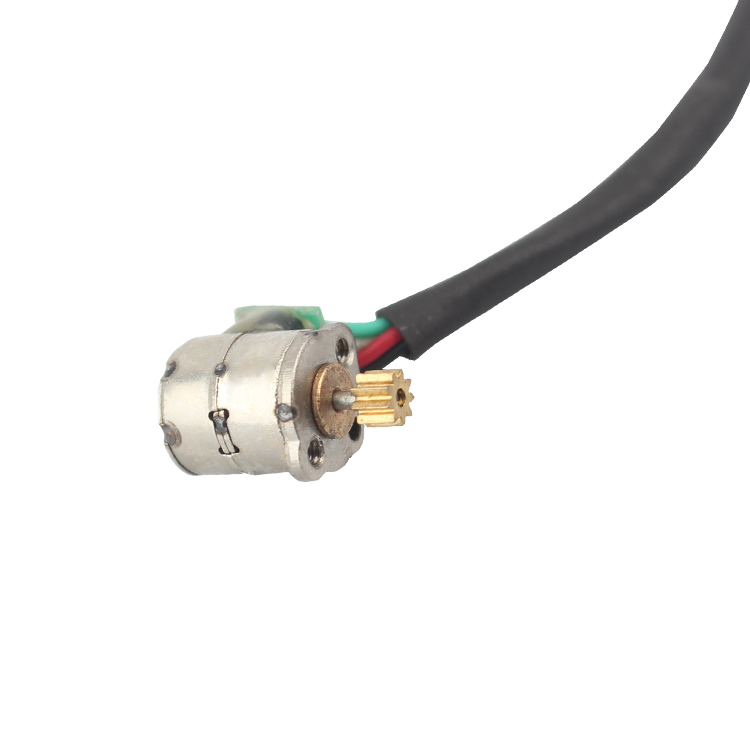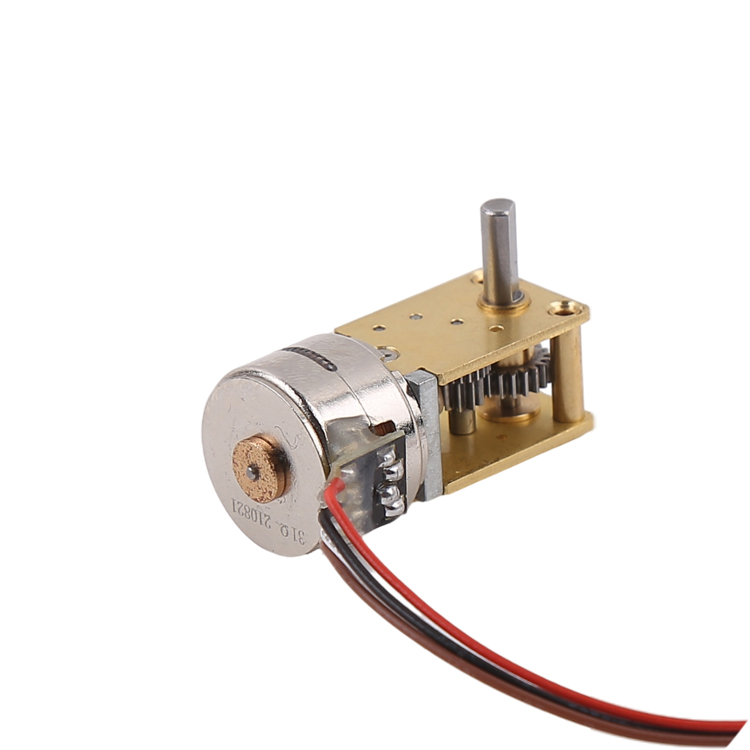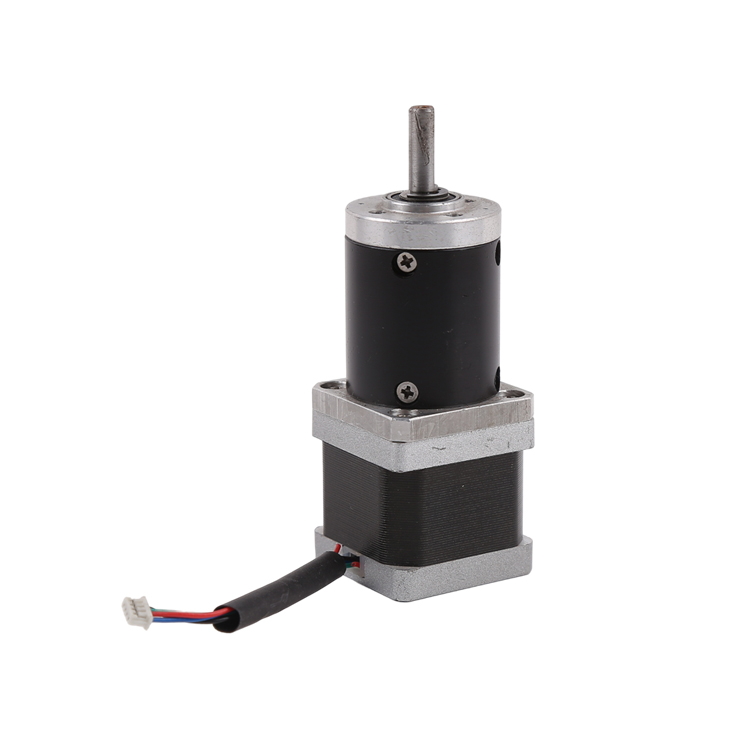| Step Angle (°) | Motor length (mm) | Holding torque (g*cm) | Current /phase (A/phase) |
Resistance (Ω/phase) | Inductance (mH/phase) | No. of leads | Rotational inertia (g*cm2) | Weight (KG) |
| 1.8 | 30 | 180 | 0.6 | 6.5 | 1.7 | 4 | 1.6 | 0.06 |
| 1.8 | 38 | 300 | 0.6 | 10 | 2.5 | 4 | 2.2 | 0.08 |
| 1.8 | 42 | 300 | 0.8 | 5.4 | 1.5 | 4 | 2.9 | 0.06 |

 Customers should follow the principle of “selecting stepper motors first, then select driver based on existing stepper motor” It is best not to use the full-step driving mode to drive a hybrid stepping motor, and the vibration is bigger under full-step driving. Hybrid stepper motor is more suitable for low-speed occasions. We suggest the speed does not exceed 1000 rpm (6666PPS at 0.9 degrees), preferably between 1000-3000PPS (0.9 degrees), and it can be attached with a gearbox to lower it’s speed. The motor has high working efficiency and low noise at suitable frequency. Due to historical reasons, only the motor with a nominal 12V voltage uses 12V. Other rated voltage on design drawing is not exactly the most suitable driving voltage for the motor. Customers should choose suitable driving voltage and suitable driver based on own requirement. When the motor is used with high speed or large load, it generally does not start at the working speed directly. We suggest to gradually increases the frequency and speed. For two reasons: First, the motor does not lose steps, and second, it can reduce noise and improve the positioning accuracy. The motor should not work in the vibration area(below 600 PPS ). If it must be used at slow speed, vibration problem could be reduced by changing the voltage, current or adding some damping. When the motor works below 600PPS (0.9 degrees), it should be driven by small current, large inductance and low voltage. For loads with a large moment of inertia, a large size motor should be selected. When higher precision is required, it could be solved by adding gearbox, increasing the motor speed, or using subdivision driving. Also a 5-phase motor(unipolar motor) could be used, but the price of the entire system is relatively expensive, so it’s rarely used. Stepper motor size: We currently have 20mm(NEMA8), 28mm(NEMA11), 35mm(NEMA14), 42mm(NEMA17), 57mm(NEMA23), 86mm(NEMA34) hybrid stepper motors. We suggest to determine motor size first, then confirm other parameter, when you select a hybrid stepper motor.
Customers should follow the principle of “selecting stepper motors first, then select driver based on existing stepper motor” It is best not to use the full-step driving mode to drive a hybrid stepping motor, and the vibration is bigger under full-step driving. Hybrid stepper motor is more suitable for low-speed occasions. We suggest the speed does not exceed 1000 rpm (6666PPS at 0.9 degrees), preferably between 1000-3000PPS (0.9 degrees), and it can be attached with a gearbox to lower it’s speed. The motor has high working efficiency and low noise at suitable frequency. Due to historical reasons, only the motor with a nominal 12V voltage uses 12V. Other rated voltage on design drawing is not exactly the most suitable driving voltage for the motor. Customers should choose suitable driving voltage and suitable driver based on own requirement. When the motor is used with high speed or large load, it generally does not start at the working speed directly. We suggest to gradually increases the frequency and speed. For two reasons: First, the motor does not lose steps, and second, it can reduce noise and improve the positioning accuracy. The motor should not work in the vibration area(below 600 PPS ). If it must be used at slow speed, vibration problem could be reduced by changing the voltage, current or adding some damping. When the motor works below 600PPS (0.9 degrees), it should be driven by small current, large inductance and low voltage. For loads with a large moment of inertia, a large size motor should be selected. When higher precision is required, it could be solved by adding gearbox, increasing the motor speed, or using subdivision driving. Also a 5-phase motor(unipolar motor) could be used, but the price of the entire system is relatively expensive, so it’s rarely used. Stepper motor size: We currently have 20mm(NEMA8), 28mm(NEMA11), 35mm(NEMA14), 42mm(NEMA17), 57mm(NEMA23), 86mm(NEMA34) hybrid stepper motors. We suggest to determine motor size first, then confirm other parameter, when you select a hybrid stepper motor. Due to high resolution of hybrid stepper motor’s (200 or 400 steps per revolution), they are widely used for applications requiring high precision, such as: 3D printing Industrial control(CNC, automatic milling machine, textile machinery) Computer peripherals Packing machine And other automatic systems requiring high precision control.
Due to high resolution of hybrid stepper motor’s (200 or 400 steps per revolution), they are widely used for applications requiring high precision, such as: 3D printing Industrial control(CNC, automatic milling machine, textile machinery) Computer peripherals Packing machine And other automatic systems requiring high precision control.
 1.How to reduce the heat of the stepper motor: Reduce heat generation is to reduce copper loss and iron loss. Reduce copper loss in two directions, reduce resistance and current, which requires the selection of small resistance and rated current as small as possible when the motor, the two-phase motor, can use the motor in series without parallel motor. But this often contradicts the requirements of torque and high speed. For the selected motor, the drive's automatic half-current control function and offline function should be fully utilized, the former automatically reduces the current when the motor is at rest, and the latter simply cuts off the current. In addition, the subdivision drive, because the current waveform is close to sinusoidal, less harmonics, motor heating will also be less. There are few ways to reduce iron loss, and the voltage level is related to it. Although a motor driven by high voltage will bring an increase in high-speed characteristics, it also brings an increase in heat generation. So we should choose the right drive voltage level, taking into account the high speed, smoothness and heat, noise and other indicators.
1.How to reduce the heat of the stepper motor: Reduce heat generation is to reduce copper loss and iron loss. Reduce copper loss in two directions, reduce resistance and current, which requires the selection of small resistance and rated current as small as possible when the motor, the two-phase motor, can use the motor in series without parallel motor. But this often contradicts the requirements of torque and high speed. For the selected motor, the drive's automatic half-current control function and offline function should be fully utilized, the former automatically reduces the current when the motor is at rest, and the latter simply cuts off the current. In addition, the subdivision drive, because the current waveform is close to sinusoidal, less harmonics, motor heating will also be less. There are few ways to reduce iron loss, and the voltage level is related to it. Although a motor driven by high voltage will bring an increase in high-speed characteristics, it also brings an increase in heat generation. So we should choose the right drive voltage level, taking into account the high speed, smoothness and heat, noise and other indicators.













